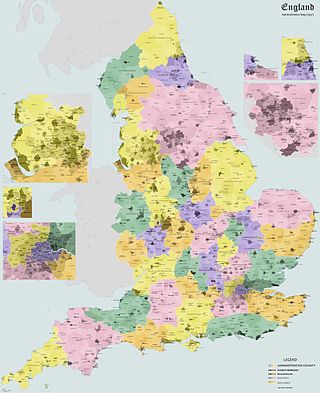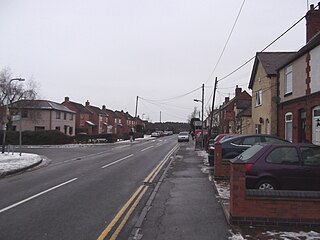
North Warwickshire is a local government district with borough status in Warwickshire, England. The borough includes the two towns of Atherstone and Coleshill, and the large villages of Hartshill, Kingsbury, Mancetter, Polesworth and Water Orton along with smaller villages and surrounding rural areas.

The Metropolitan Borough of Solihull is a metropolitan borough in West Midlands county, England. It is named after its largest town, Solihull, from which Solihull Metropolitan Borough Council is based. For Eurostat purposes it is a NUTS 3 region and is one of seven boroughs or unitary districts that comprise the "West Midlands" NUTS 2 region. Much of the large residential population in the north of the borough centres on the communities of Castle Bromwich, Kingshurst, Marston Green and Smith's Wood as well as the towns of Chelmsley Wood and Fordbridge. In the south are the towns of Shirley and Solihull, as well as the large villages of Knowle, Dorridge, Meriden and Balsall Common.

Tamworth is a constituency represented in the House of Commons of the UK Parliament, based on the town of Tamworth in Staffordshire, England. The seat is currently represented by Sarah Edwards of the Labour Party, re-elected in the UK 2024 general election.

Drayton Manor, one of Britain's lost houses, was a British stately home at Drayton Bassett, since its formation in the District of Lichfield, Staffordshire, England. In modern administrative areas, it was first put into Tamworth Poor Law Union and similar Rural Sanitary District, 1894 to 1934 saw its inclusion in Tamworth Rural District, and in the next forty years it lay in the 1974-abolished Lichfield Rural District.

Amington is a area of Tamworth in Staffordshire, England. Formerly a distinct village, it is now part of the Tamworth borough, with no gap between it and the neighbouring wards of Bolehall, Glascote, Glascote Heath and Stonydelph.
Atherstone Rural District was located in the administrative county of Warwickshire, England, from 1894 to 1974. It was named after its main town and administrative headquarters of Atherstone.

Banbury was a rural district in Oxfordshire, England from 1894 to 1974. It was formed under the Local Government Act 1894 from the bulk of the Banbury rural sanitary district, which had been divided among three counties. The Warwickshire part of the rural sanitary district formed the Farnborough Rural District, whilst the area in Northamptonshire formed the Middleton Cheney Rural District.
Repton was a rural district in Derbyshire, England from 1894 to 1974.
Gnosall was a rural district in Staffordshire, England from 1894 to 1934. It was formed under the Local Government Act 1894 from that part of the Newport Rural Sanitary District which was in Staffordshire.
Cannock was a rural district in Staffordshire, England, from 1894 to 1974.

Wood End is a former Pit village in North Warwickshire, England. It lies to the south east of Tamworth and close to the border with Staffordshire. It grew around the former Kingsbury Colliery but now it serves as a commuter village to Tamworth. It has a church, a primary school, a co-operative store, a working men's club and a village hall. The population of Wood End is 2,205, but from the 2011 Census has been included in Kingsbury.

The A423 road is a primary A road in England in two sections. The main section leads from central Banbury to the A45 near Coventry.

South Staffordshire Water plc known as South Staffs Water is a UK water supply company owned by a privately owned utilities company serving parts of Staffordshire, the West Midlands, as well as small areas of surrounding counties in England. South Staffordshire Water plc is part of South Staffordshire plc. It purchased Cambridge Water in 2011. In 2013, KKR & Co. L.P., a company registered in the United States of America, acquired South Staffordshire Water from Alinda Infrastructure Fund. As of April 2018, KKR & Co. has agreed to sell its 75% equity stake in South Staffordshire Water to Arjun Infrastructure Partners (AIP).

Shuttington is a village and civil parish in North Warwickshire, England, situated north-east of Tamworth, Staffordshire. In the 2001 census, the parish, which also includes Alvecote, had a population of 563, decreasing to 536 at the 2011 census. The River Anker flows through the parish, with Shuttington north-east of the river, and Alvecote south of it. The West Coast Main Line passes through Alvecote, with the Coventry Canal parallel to it and a marina south of the canal. Most of the parish is rural, including the village of Shuttington, although there was colliery alongside the railway at Alvecote.
Birchmoor is a former coal mining village in the North Warwickshire district of Warwickshire, England. It lies about one mile southwest of Polesworth, and 2 miles east of Tamworth, from which it is separated by the M42 motorway and the Staffordshire county boundary. It is generally considered as a district of Polesworth. Birchmoor Colliery was opened in 1860 and closed in 1927.

Harlaston is a village and civil parish in Staffordshire, England. It lies on the River Mease, about 5 miles (8 km) north of Tamworth. There is an Early English church, dedicated to St Matthew, and a public house, the White Lion.

Thorpe Constantine is a small village and civil parish in Staffordshire, England. It lies about 6 miles (10 km) north-east of Tamworth and 6 miles south-west of Measham. The nucleus of the parish is the Thorpe estate.
Lichfield was a rural district in the county of Staffordshire, England from 1894 to 1974.
South Staffordshire College is a further education college located over four sites in Staffordshire, England.

Perry Barr Urban District, or Urban District of Perry Barr was an area of England for local government administrative purposes. As such, it was administered locally by Perry Barr Urban District Council. It took its name from the included hamlet of Perry Barr, which was until then in the parish of Handsworth. It was created in 1894 as a result of the Local Government Act 1894, as a subdivision of the administrative county of Staffordshire, and existed until 1928, when it largely became part of Birmingham, and so also part of the county of Warwickshire. At that time, small parts of the district were granted to the Royal Town of Sutton Coldfield, also in Warwickshire, and to West Bromwich. In 1974, Birmingham was taken out of Warwickshire and became part of the West Midlands county, as was Sutton Coldfield, which became part of Birmingham at the same time.












